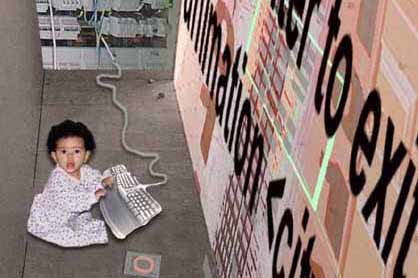|
|
||||||
| image | activities | contacts | links | italiano | ||||||
|
5th
International Festival for Architecture in Video |
||||||
|
introduction program - dates - authors - works - exhibitions partners credits previous editions mailto |
 Richard Koeck Future Architecture USA 2000 Architecture and the life in the city of the third millennium might be one in between virtual realities and our real world. We might find our physical bodies in an environment surrounded by more than one reality. Inhabitants of cities might live as much in them on a virtual basis as they live physical in them. People might have the ability to create their own virtual cities according to their individual human needs and desires. A significant amount of their time they might spend physical isolated, but brain-stimulated in a virtual world - in a virtual city. Image one shows "one" animated city as we know it today. A multi-layered, traffic dominated vital space, - melting pot of cultures and social life. The upper left corner shows the binary code of (0010101) in a mirrored form, indicating that the shown image is a view from the inside of a computer screen into the outside world. Image two shows how a computer system zooms closer to one of the buildings, looking for the "one reality" of its own existence. The binary code as symbol of dominating computer technology is projected on the architectural facades. Image three shows how a computer system zooms closer to one of the façades, recognizing that there is apparently "more than one reality" projected on the building façade. One projected image on the façade shows exactly the previous "image two". Image four zooms through the façade into the building, finding a child as animator and creator of the virtual city reality shown in the previous images. The child's real physical space is rather, empty and cold and is spatial constricted by a large computer in the background. The city of the future might be by far more detached from materiality as we can image now. Richard Koeck was born on 21.09.1969 in Augsburg, Germany. From early age he gained practical experience in his parent's construction company, before his father died in 1988. He qualified for the architectural studies in higher education by receiving the A-level certificate (Allgemeine Hochschulreife) in Germany in 1989. In 1993 he began his architectural studies at the FH-Augsburg, University of Applied Sciences in Germany. During his studies he was awarded from the German Academic Exchange Council (DAAD-Deutscher Akademischer Austauschdienst) a one-year-long research scholarship for extended studies in the United States. He received the German academic title as architectural engineer (Diplom-Ingenieur für Architektur) from the FH-Augsburg in 1998. Richard Koeck worked professionally in Germany on several new buildings as well as on redevelopment projects in historical urban context. Since 1998 he partnered with his wife Monika Koeck in a number of international competitions exploring the limitations of digital media. In 1999 they worked as team on the "EUROANDOM" international urban competition in Montreuil, France. At the Biennale in Venice, Italy his work was selected and exhibited, emphasizing the challenges that the "The City of the Third Millennium" will face in an age of digitized realities. Since 1998 Richard Koeck teaches as Visiting Assistant Professor at the University of Oklahoma, USA, where he received in 2000 presidential recognition as "Faculty in Residence". He researches and publishes in the areas of Modern and Contemporary architecture foremost in the US and Europe. Currently he dedicates his work to the exploration of digital applications concerning ‘moving images’ in architecture. |
WWW | ||||